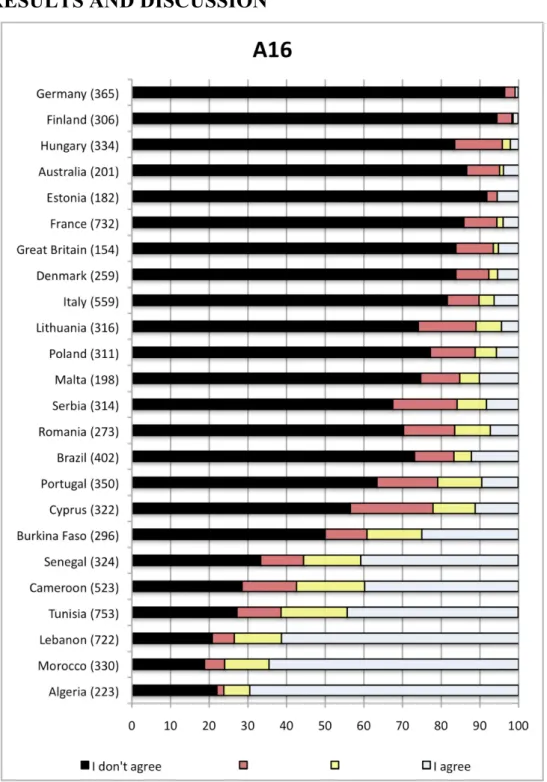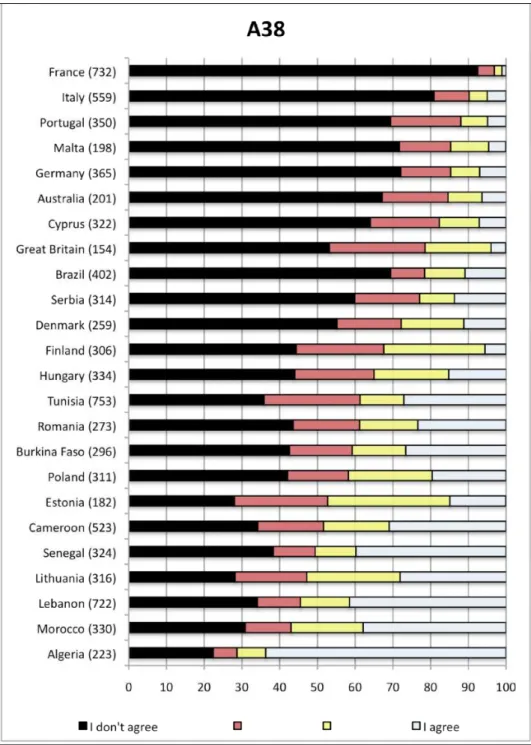HAL Id: hal-01054209
https://hal.archives-ouvertes.fr/hal-01054209
Submitted on 5 Aug 2014HAL is a multi-disciplinary open access archive for the deposit and dissemination of sci-entific research documents, whether they are pub-lished or not. The documents may come from teaching and research institutions in France or abroad, or from public or private research centers.
L’archive ouverte pluridisciplinaire HAL, est destinée au dépôt et à la diffusion de documents scientifiques de niveau recherche, publiés ou non, émanant des établissements d’enseignement et de recherche français ou étrangers, des laboratoires publics ou privés.
Diversity of teachers’ conceptions related to environment
and human rights. A survey in 24 countries.
Pierre Clément, Caravita Silvia
To cite this version:
Pierre Clément, Caravita Silvia. Diversity of teachers’ conceptions related to environment and human rights. A survey in 24 countries.. ESERA 2011 Conference: Science Learning and Citizenship, Sep 2011, Lyon, France. pp.42-48. �hal-01054209�
Clément P. & Caravita S., 2012 ‐ Diversity of teachers’ conceptions related to environment and human rights. A survey in 24 countries. In C.Bruguière, A.Tiberghien & P.Clément (eds), Ebook Proceedings of the
ESERA 2011 Conference, Science Learning and Citizenship, Part 8, p. 42‐48.
DIVERSITY OF TEACHERS’ CONCEPTIONS RELATED TO
ENVIRONMENT AND HUMAN RIGHTS.
A SURVEY IN 24 COUNTRIES
Pierre Clément (1) and Silvia Caravita (2)(1) S2HEP, University Lyon 1 (France) Pierre.Clement@univ-lyon1.fr (2) IRPPS-CNR, Roma (Italy), silvia.caravita@istc.cnr.it
In collaboration with Khammar F. (Algeria), Quinn F. (Australia),
Lopes G. and Paloma S. (Brazil), Béré-Yoda I. (Burkina Faso), Ntam Nchia L. (Cameroon), Valanides N. (Cyprus), Pata K. and Sarapuu T. (Estonia), Rauma A.L. (Finland), Laurent Ch. and Castéra J. (France), Bogner F. (Germany), Varga A. (Hungary), Valente A. (Italy), Khalil I. (Lebanon), Turcinaviciene J. (Lithuania), Pace P. (Malta),
Selmaoui S. (Morocco), Carvalho G. (Portugal), Samonek-Miciuk E. (Poland),
Kozan A. (Romania), Thiaw M.S. (Senegal), Stanisavljevic J. (Serbia), Abrougui M. (Tunisia)
Abstract: The environmental, social and economical dimensions of ESD include human rights as equality of all the human beings independently to their gender, ethnic group, religion or sexual orientation. To analyse teachers’ conceptions on environment and on human rights, and to identify eventual links between them and with controlled parameters, a large survey has been done in 24 countries (8 749 teachers). The data are submitted to multivariate analyses.
In the less developed countries, the teachers’ conceptions are more anthropocentric, less awareness of the problem of the limit of resources in our planet, and less reticent to use GMO (genetically modified organisms). These teachers are more believing in God, more practising religion, more for “a strong central power”, “against the separation between science and religion”. The priority of ESD in these countries is poverty and development, while it is to avoid wasting and excessive consumption in the most developed countries.
The teachers with the most anthropocentric conceptions more agree with these propositions: “It is for biological reasons that women more often than men take care of housekeeping” and “Ethnic groups are genetically different and that is why some are superior to others”, and more disagree with: “Homosexual couples should have the same rights as heterosexual couples”. These points illustrate that some socio-cultural traditions can differ from values of ESD (the universal human rights).
THEORETICAL BACKGROUND
Most of the countries include now ESD (Education for a Sustainable Development) in their national curricula, even if some of them still call it EE (Environmental Education, e.g. in Brazil or in Colombia, where EE already included social, economical and political dimensions), or EES (Environmental Education for Sustainability, e.g. in Australia) avoiding the word “Development” more understood as “Growth” than as a possible “Metamorphosis” of our societies. The topics of ESD are far to be limited to ecology or environmental problems; they also include the social and economical dimensions of SD (Sustainable Development, Brundtland report 1987), including human rights.
ESD is focused on learners’ competences. « The conceptualization adopted in DeSeCo (OECD 2002) is holistic in the sense that it integrated and related external demands, individual attributes (including ethics and values) and context as essential elements of competent performance” (Rychen, 2004, page 21). In each competence, “knowledge (including tacit knowledge), motivation, capacities, attitudes, values, emotions, (are) mobilized for effective actions in particular contexts » (Rychen, 2004, page 22).
The values underlying ESD were categorized in diverse works (synthesis in Caravita et al. 2008). Several of these values are also underlying Education for All, Education to Citizenship and Human Rights : e.g. for the equality of all the human beings independently to their gender, ethnic group, religion or sexual orientation (UNESCO, 2009, page 9). Other values, more focused on Environment and Sustainability, are specific to ESD.
ESD is facing a paradoxical injunction, taking into account the local socio-cultural specificities, but also universal values (mainly scientific and citizenship values). To face this question, we did an international survey implying different socio-cultural contexts. Our research is trying to identify eventual interactions between scientific knowledge and values in teachers’ conceptions (as suggested by the KVP model: Clément 2006, analysing conceptions as possible interactions between scientific knowledge, K, values, V and social practices, P), and the present communication is focused on the analysis of eventual correlations between values related to environment and those related to some human rights.
RESEARCH QUESTION
What are the teachers’ conceptions, and mainly their values implied in competencies for ESD, in a variety of different countries? More precisely, is there some correlation between their values related to environment (as ecocentric or anthropocentric ethics) and their values related to some human rights as equality among all the human beings, independently to their gender, ethnic group, sexual orientation, or religion?
METHODS
The teachers’ conceptions were analysed from their anonymous answers to a large questionnaire elaborated by the Biohead-Citizen project (Biology, Health and Environmental Education for better Citizenship, 2004-2008), elaborated and validated collectively during two years, using previous interviews, pilot test, etc (Clément & Carvalho 2007). 27 questions are related to nature, environment and environmental education, other questions are dealing with the eventual biological justification of differences related to the gender, to ethnic groups or to sexual orientation; other questions concern personal information, including political and religious opinions. We present here only some results of the survey.
In each country, the sampling was well balanced: 1/3 primary schools teachers; 1/3 secondary schools teachers of biology; and 1/3 secondary schools teachers of language. In each sample, there were half of in-service teachers, and half of pre-service teachers (end of their training). The countries were chosen from their diversity: 18 for the Biohead-Citizen project (13 in all Europe, 4 in Arabic countries and 1 in sub-Saharan Africa). More recently, were added 2 other European countries (Denmark and Serbia), 2 countries of sub-Saharan Africa (Burkina-Faso and Cameroun), Brazil and Australia. The number of the interviewed teachers in each of the 24 countries is indicated below on the figures 1 and 2 (total = 8 749).
The distribution of answers inside each of the 24 countries can be illustrated by histograms as below in figures 1 and 2. The data were analysed with different multivariate analyses (presented in other works as in Munoz et al., 2009). A between analysis was used to identify the answers which discriminate the most the countries, and a test of randomisation (Monte Carlo type) shows that the difference among the countries is very significant (p < 0.0001). A Co-Inertia analysis correlates the PCA from the questions related to environment with the PCA from questions related to the teachers’ socio-political and religious opinions. Another Co-Inertia Analysis correlates the environmental variables with those related to some human rights (equality men – women, among ethnic groups, etc.).
MAIN RESULTS AND DISCUSSION
Figure 1 – Answers of the 8 749 teachers (grouped by country) to the questions A16 - “Our planet has unlimited natural resources”
Figure 2 – Answers of the 8 749 teachers (grouped by country) to the question A38 – “It is for biological reasons that women more often than men take care of housekeeping”
The 24 countries very significantly differ from several questions related to teachers’ conceptions on utilisation of the environment (Several questions concerning teachers’conceptions on utilization of the environment make the difference mong the 24 countries:): as questions A16 (figure 1: “Our planet has unlimited natural resources”), A17 (“Society will continue to solve even the biggest environmental problems”), A18 (“Human beings are more important than other living beings”), A39 (“Genetically modified plants are good for the environment because their cultivation will reduce the use of chemical pesticides (e.g. insecticides, herbicides)”).
Globally, teachers of the less developed countries have more anthropocentric conceptions, being less awareness than their colleagues from other countries of the problem of the limit of resources in our planet, and less reticent to use GMO (genetically modified organisms). These conceptions probably can be related with the importance of poverty in these countries, and the urgent necessity of a better economical development. The implementation of ESD in these countries has to take into account this specificity, not using the same situations as in developed countries where inverse problems are a priority (to avoid wasting and excessive consumption).
The first Co-Inertia Analysis shows a significant correlation between the same environmental variables (anthropocentric values) and some religious and socio-political parameters. The teachers having the most anthropocentric conceptions are the most believing in God and practicing religion, independently to the religion (e.g. in figure 1, A16 : most of the teachers in Cameroon are Christian, while >90% of them are Muslim in Senegal). Politically, these teachers are more for “a strong central power”, “against the separation between science and religion”, and for “laws to help firms”. All these parameters are probably linked to the low level of development correlated with stronger religious practices.
The second Co-Inertia Analysis shows another set of correlations. The teachers with the most anthropocentric conceptions more agree, for instance, with the propositions A38 (figure 2: “It is for biological reasons that women more often than men take care of housekeeping”) and A35 (“Ethnic groups are genetically different and that is why some are superior to others”), and more disagree with A41 (“Homosexual couples should have the same rights as heterosexual couples”). The biological justification of superiority of men or of some ethnic groups is today considered as ideological and not scientific; as an interaction KV (knowledge and values) justifying some still actual social practices (P). Why is it so present in teachers’ conceptions in Arabic countries, but also in sub-Saharan Africa, and in countries of North and East Europe? These points, as other comments of the figures 1 and 2, and of all our results, will be presented and discussed in a larger publication. They illustrate that some socio-cultural traditions can differ from some values of ESD (the universal human rights).
REFERENCES
Caravita, S., Valente, A, Luzi, D., Pace, P., Khalil, I., Berthou, G., Valanides, N., Kozan-Naumescu, A., Clément, P. (2008). Construction and validation of textbook analysis grids for ecology and environmental education. Science Education International, 19, 2, p. 97-116. Biohead-Citizen (2004-2008). Biology, Health and Environmental Education for better Citizenship, STREP CIT2-CT-2004-506015, E. C., Brussels, FP6, Priority 7
Brundtland (1987). The Report of the Brundtland Commission, Our Common Future, Oxford University Press
Clément, P. (2006) Didactic transposition and the KVP model: conceptions as interactions between scientific knowledge, values and social practices. Proceedings ESERA Summer School, IEC, Braga (Portugal), p.9-18.
Clément, P. & Carvalho, G. (2007). Biology, Health and Environmental Education for better Citizenship: teachers' conceptions and textbook analysis in 19 countries. Proceedings WCCES XIII (World Council of Comparative Education Societies), Sarajevo, CD-Rom, 15 pp.
Munoz, F., Bogner, F., Clément, P. & Carvalho, G.S. (2009). Teachers' conceptions of nature and environment in 16 countries. Journal of Environmental Psychology, 29: 407-413.
OECD (2002). DeSeCo Project. Definition and Selection of Competencies.
www.deseco.admin.ch
Rychen D.S. (2004). Key competencies for all : an overlapping conceptual frame of reference. In : Developing key competencies in education. In D.S. Rychen & A. Thiana, International Bureau of Education, UNESCO.
UNESCO (2009). Contextes et structures de l’Education pour le développement durable, DEDD 2005-2014, page 9.

